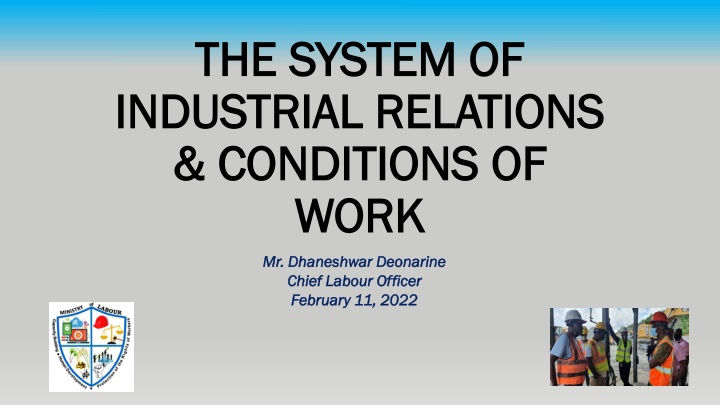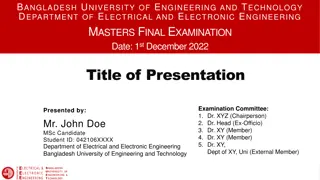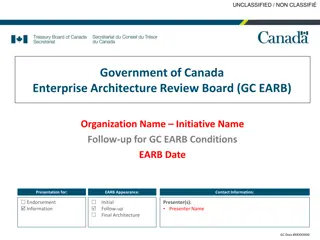
Industrial Relations and Labour Administration in Guyana
Exploring the system of industrial relations, labour administration, and legal framework in Guyana, including the roles of the Ministry of Labour, constitution guarantees, and national legislation. Learn about collective bargaining, mediation, arbitration, and the protection of workers' rights.
Download Presentation

Please find below an Image/Link to download the presentation.
The content on the website is provided AS IS for your information and personal use only. It may not be sold, licensed, or shared on other websites without obtaining consent from the author. If you encounter any issues during the download, it is possible that the publisher has removed the file from their server.
You are allowed to download the files provided on this website for personal or commercial use, subject to the condition that they are used lawfully. All files are the property of their respective owners.
The content on the website is provided AS IS for your information and personal use only. It may not be sold, licensed, or shared on other websites without obtaining consent from the author.
E N D
Presentation Transcript
THE SYSTEM OF THE SYSTEM OF INDUSTRIAL RELATIONS INDUSTRIAL RELATIONS & CONDITIONS OF & CONDITIONS OF WORK WORK Mr. Mr. Dhaneshwar Dhaneshwar Deonarine Chief Chief Labour Labour Officer February 11, 2022 February 11, 2022 Deonarine Officer
MINISTRY OF LABOUR (MOL) MINISTRY OF LABOUR (MOL) Responsible for labour administration services through various activities. The MOL mandate includes: 7. Setting up and servicing arbitration tribunals; 8. Labour and occupational safety and health inspections and enforcement; 9. Employment, recruitment and placement services; 10. Regulating recruitment agencies; 11. Capacity building for HRD in industrial and vocational training; 12. Promoting tripartite collaboration and consultations. 1. Establishing the national labour policy; 2. Promoting sound industrial relations policies and practices through collective bargaining; 3. Advisory support services to trade unions, employers and state agencies; 4. Resolving labour disputes; 5. Conciliation/mediation services; 6. Certification of trade unions;
INDUSTRIAL RELATIONS INDUSTRIAL RELATIONS SYSTEM SYSTEM EXTERNAL ENV OUTPUTS Contexts Partners Processes Rules Wages, hours and Conditions of employment Collective Bargaining Mediation Conciliation Arbitration Certification of TU 1. Employers rep. org. 2. Workers rep. org 3. Government Social Economic Legal Tech. Benefits Duties and obligations Job rights Mgt rights Mechanisms for converting inputs into outputs Feedback Loop
Legal Framework Legal Framework Constitution of Guyana National Legislations and Regulations International Labour Conventions of the ILO
The Constitution The Constitution Explicates LABOUR OF THE PEOPLE as the source of growth of social wealth and well-being (Article 22, Part I, Chapter II) Guarantees a right to work (Article 149A, Part 2) Right to rest, recreation and leisure (Article 23, Part I, Chapter II) Right to to equal equal pay pay for for equal equal work work or or work work of of equal of of work work (Article 22, Part I, Chapter II) Protection from FORCED FORCED LABOUR LABOUR ( (Article 140) Freedom to belong belong to to a a trade trade union union for the protection of his/her interests (Article 147) equal value, value, and and to to just just conditions conditions
National Legislation: Conditions of National Legislation: Conditions of Work Work Labour Act, Chapter 98:01 Termination of Employment and Severance Pay Act, No 19 of 1997 Prevention of Discrimination Act No. 26 of 1997 Labour (Conditions of Employment of Certain Workers) Act Chapter 99:03 Leave With Pay Act Chapter 99:02 Labour (National Minimum Wage) Order 2016 Occupational Safety and Health Act No. 32 0f 1997 Trade Union Recognition Act No. 33 of 1997
OVERTIME OVERTIME The normal work week is 40 hours and it shall not exceed 5 days per week: Labour (National (National Minimum Minimum Wage) Wage) Order Order 2016 2016 (S (S6 6) ) Labour The normal working hours in a day are eight (8) hours More More than for every hour or part of an hour so worked than 8 8 hours hours - - one one- -half half ( (1 1 ) ) times times the rate at which the worker would be paid Sundays Sundays and half (1 ) times the normal rate of pay per hour for all hours worked (S S 4 4 Labour (Conditions (Conditions of of Employment Employment of of Certain Certain Workers) Workers) Act and Public Public Holidays Holidays - Workers are to be paid at a minimum of one and one- Labour Act
FACTORY OVERTIME FACTORY OVERTIME Workers employed in a FACTORY are to be paid twice (2 times) their normal rate of pay for working on Sundays and the following Public Holidays: S S 24 24 ( (4 4) ) Factories and and Holidays) Holidays) Act, Act, Cap 1. 1. Labour Labour Day Day (May 2. 2. Good Good Friday Friday 3. 3. Easter Easter Monday Monday 4. 4. Christmas Christmas 5. 5. Eid Eid- -ul ul- -Adha Adha 6. 6. Phagwah Phagwah All other public holidays attract payment at one and a half (1 times) the normal rate of pay. If any holiday falls on a Sunday, then the following day will attract this rate of overtime. Factories (Hours Cap. . 95 95: :02 02 (May 1 1st st ) ) (Hours Note Note: : Overtime Overtime for for Factory Factory Workers Workers : : 1. Employer and employee cannot contract for time-off in lieu of overtime pay cannot agree to 2. Employed Employed in in a a factor, in in a a factor factor - s s24 labour factor, or or in in any 24 = = not restricted to manual any occupation occupation
TERMINATION AND SEVERANCE TERMINATION AND SEVERANCE An employer can terminate a contract of employment for an unspecific period of time: by mutual consent of the employer and employee; by either the employer or employee by notice given to or served upon, the other party Termination S7,TESPA Ground of redundancy under S12 by either the employer or employee for good and sufficient cause;
NOTICE PERIOD FOR TERMINATION NOTICE PERIOD FOR TERMINATION Employed for Less Less than one year Employed for One year of more more Two Weeks Notice One Month s Notice * * The employee is also required to give the same period of notice to the employer in the The employee is also required to give the same period of notice to the employer in the circumstance where he/she terminates his/her contract of employment. circumstance where he/she terminates his/her contract of employment.
PAYMENT IN LIEU OF NOTICE : PAYMENT IN LIEU OF NOTICE : s16,tespa s16,tespa Payment in lieu of notice is paid to the employee when his/her employment has been terminated, and the employer pays the employee instead of having that employee work during the notice period. The employee is paid remuneration and benefits that he/she would have earned during the notice period.
TERMINATION OF TERMINATION OF EMPLOYMENT DURING THE EMPLOYMENT DURING THE PROBATIONARY PERIOD PROBATIONARY PERIOD LAY LAY OFFS OFFS No layoff of an employee shall exceed six (6) weeks: S S14 The employer or employee may terminate the employment contract without notice : S S9 9,TESPA 14,TESPA ,TESPA ,TESPA
CALCULATING THE SEVERANCE OR CALCULATING THE SEVERANCE OR REDUNDANCY ALLOWANCE REDUNDANCY ALLOWANCE One (1) week s wages for each year of service 1 to 5 years of service Two (2) weeks wages for each year of service after the fifth, and up to the tenth year. 5 to 10 years of service * * Any vacation vacation must paid paid employee employee payment payment in in lieu of of notice notice termination termination. . Any unused unused must be to to be the the and and lieu of of Three (3) weeks wages for each completed year of service in excess of ten years, up to a maximum of fifty-two (52) weeks. In excess of 10 years of service
UNFAIR DISMISSALS S8 (1), TESPA The following reasons are not good or sufficient cause for dismissals or for imposition of disciplinary action: 1. an employee's race, sex, religion, colour, ethnic origin, national extraction, political opinion, family responsibility or marital status; 2. age, subject to retirement law or collective agreement; 3. pregnancy, or reason connected with pregnancy; 4. certified sick leave; 5. compulsory military service; 6. participation in industrial action in conformity with the provisions of any law or collective agreement; 7. The filing by an employee of a complaint, or the participation in proceedings against an employer involving alleged violations of any rule of law.
Leave: S3, Leave with pay act Leave: S3, Leave with pay act Weekly, Weekly, fortnight fortnight ly or ly or monthly monthly basis basis One (1) day for each month completed * * When the employment of a worker is terminated (either by the worker of the employer), the worker s leave entitlements are pro- rated and paid in lieu of such period of leave. (see Section Section 6 6 Leave Leave With Act Act Chapter Chapter 99 99: :02 One (1) day for every twenty (20) days worked Daily Daily paid paid emp emp see Pay With Pay 02). Hourly Hourly paid paid employe employe es es One (1) day for every 160 hours worked The half day is counted as a day in the computation of periods of employment and leave with pay Half Half- -day basis basis day
Minimum Wage Minimum Wage Monthly- $44, 200 * Nothing * Nothing prohibits the prohibits the payment of higher payment of higher rates than those rates than those fixed by minimum fixed by minimum wage orders wage orders Weekly- $10, 200 Daily - $2,040 Hourly- $255
WAGES Payment of Wages Payment of Wages Weekly, fortnightly or monthly, except where there is a contrary agreement: S18(3), Labour Act Every employee has the right to recover the entire amount of his/her wages, except the sum lawfully deducted (mainly NIS and PAYE), S19, Labour Act Deductions: S24, Deductions: S24, Labour Labour Act Act Not more than 1/3 of the wages per month
INSPECTIONS The Labour Officer is empowered and authorized to enter, inspect and examine any workplace at at any any hour hour of of the the day day or or night night, and: a. Examine records on wages, hours and conditions of work of all the workers; b. Interview workers regarding the conditions of work; c. Require the employer to produce any book, register or other document relating to the conditions of work, to ensure that they are in conformity with the Labour Laws; d. Enforce the posting of notices required by any law; e. Take with him a member of the police force if he has reasonable cause to apprehend any serious obstruction in executing the inspection; f. Examine the register of accidents kept and obtain from the employer information as to the causes and circumstances relating to any accident that occurred on the employer s premises. g. Examine the pay sheet relating to the workers h. Examine the leave records for all workers
RECORDS Records of wages: S10, S10, Labour Labour Act Act Record of Holidays with pay (Register of Holidays): S8, Leave with Pay Act with Pay (Register of Holidays) Regulations S8, Leave with Pay Act; S3 Holiday Register of wages paid to workers and the date on which each worker entered his/her employment: S8, S8, Labour Labour (Conditions of Employment of Certain Workers) Act (Conditions of Employment of Certain Workers) Act Records to be kept to show the TESPA is being complied with: S6, TESPA S6, TESPA Register of all Accidents to be kept: S69(7), OSH Act : S69(7), OSH Act
LEGISLATIVE REVIEW The ultimate goal ultimate goal of the review is to ensure that the labour legislative framework is germane and suitable to the policy objectives of the Government; and to ensure harmonization of the labour laws in the context of the Constitution of Guyana and all relevant ILO and other international Conventions which Guyana has signed, all in an effort to strengthen legislation protection for all workers. The specific objectives, inter alia, are: The specific objectives, inter alia, are: To have laws that are relevant, and reflect the needs of Guyana s modern social and economic construct; To ensure quick and easy resolution to industrial disputes (to reduce the number of litigation); To ensure workers and employers rights are protected (including advocacy for understanding same); To effectuate compliance with the legislative provisions by setting out penalties that will deter infractions;
How do you start the engagement with the How do you start the engagement with the Labour Department? Labour Department? Dhaneshwar Deonarine Chief Labour Officer Ministry of Labour 82 Brickdam Georgetown, Guyana South America Tel#: (592)-225-7302 Email: chieflabourofficer2021@gmail.com THANK YOU!






















